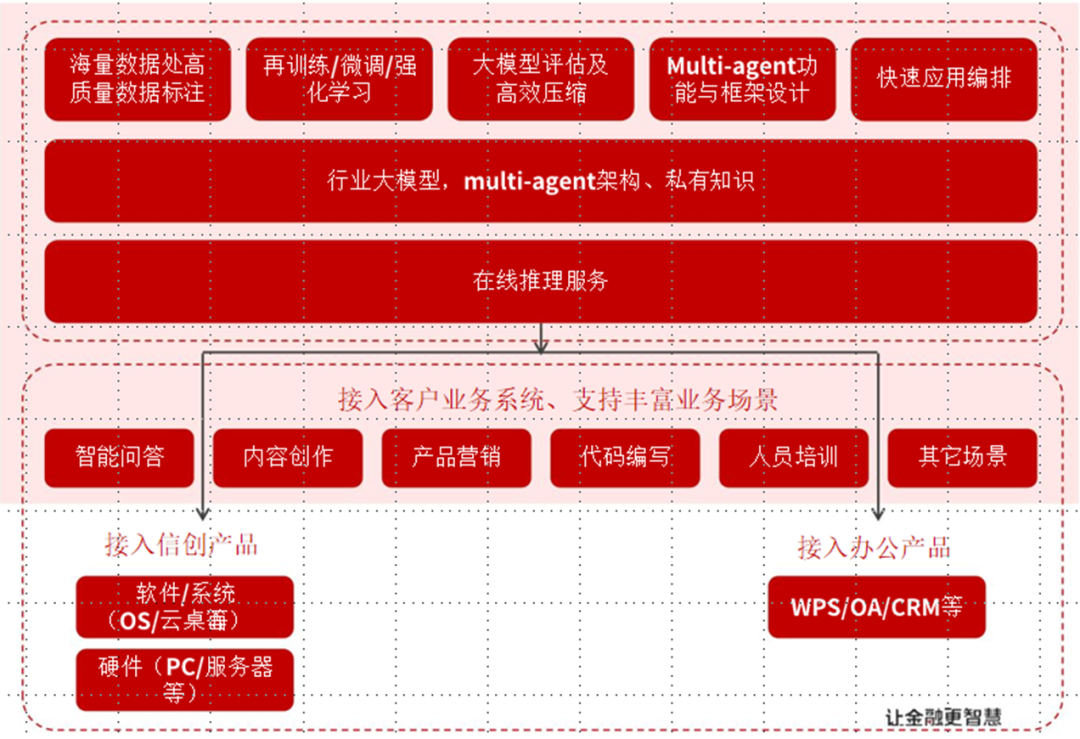Pan Titanium Technology’s generative AI Agent solution integrates mainstream open-source and closed-source large language models from home and abroad, based on a self-developed Multi-Agent architecture, to build an enterprise-level service ecosystem that provides scenario-based solutions for various government, enterprise, and industry clients in finance, education, and other fields.
Background of the Solution

1. Industry and Policy Background
The policy background for the development of generative AI Agents mainly includes three aspects: technological advancement, market demand, and policy support. First, technological advancement is a crucial factor driving the development of AI Agents. In recent years, continuous breakthroughs in deep learning, natural language processing, and computer vision technologies have led to significant progress in AI Agents’ perception, understanding, and decision-making capabilities. The integrated application of these technologies allows AI Agents to better understand user intentions and provide more accurate services.
Secondly, the increasing market demand has also promoted the development of AI Agents. As consumers’ need for intelligent and personalized services grows, AI Agents, as intelligent systems capable of meeting these needs, have naturally become market favorites, demonstrating immense market potential.
Finally, policy support provides a strong guarantee for the development of AI Agents. These policies not only provide legal and financial support for the development of AI Agents but also promote the rapid development of related industries. The Chinese government has invested in and supported the research and development of AI technologies, facilitating technological innovation and commercialization.
2. Industry Challenges
From the perspective of industry applications, large AI models demonstrate strong potential in multiple fields, expanding from initial text generation and translation to areas such as financial risk control, creative design, and pharmaceutical research. The application boundaries of large models continue to broaden.
Large models present foundational capabilities, and the main challenge for enterprises is how to transform these capabilities into practical products. Agents serve as intermediaries between large models and specific scenarios, and while they partially address some B-end delivery issues, industry standards have not yet been finalized. Additionally, the training of generative AI requires substantial computational resources and time, involving the processing of various sensitive data, making privacy and security issues paramount.
3. Scenario Pain Points
As market competition intensifies, customer demands diversify, and technological innovations rapidly iterate, the complexity of business management is increasing. Traditional business processes and management methods can no longer meet current needs, and enterprises urgently require new solutions that can efficiently handle complex operations, improve operational efficiency, and enhance market competitiveness. Against this backdrop, AI Agents have emerged as the key to solving the complex business puzzle.
Goals of the Solution

The goals of the solution mainly include productivity enhancement, automated processes, and modern customer experiences.
1. Drive business model transformation: address issues such as complex business processes and decision-making;
2. Optimize data utilization efficiency: solve problems like redundant reporting demands, inconsistent metric standards, and difficulties in real-time responses to business changes;
3. Shorten management decision-making cycles: adapt faster to market changes and meet new business scenarios and demands.
Features of the SolutionCharacteristics

1. Multi-Agent interaction: Based on the self-developed Multi-Agent architecture, it supports interaction and interconnectivity between Agents, expanding the execution and judgment capabilities of Agents to meet more complex application scenario designs.
2. Multi-model invocation: supports the integration of mainstream domestic and international models according to enterprise needs, while allowing mixed usage of models to better leverage their advantages, improving the quality and stability of AI processing.
3. Open capabilities: Agents support publishing exclusive links or exclusive APIs, compatible with mainstream devices, and API capabilities support integration with internal enterprise systems or mainstream office software, allowing users to enjoy the efficiency improvements brought by AI Agents anytime, anywhere.
Solution Workflow Diagram


Functionality Showcase

1. Automated processes and task execution: AI Agents can make decisions and execute operations based on input data without human intervention.
2. Customer service: AI Agents can interact with customers in customer service, resolve their inquiries, and report issues when necessary, enhancing the comprehensiveness and convenience of customer service.
3. Data analysis: process and analyze large volumes of data to provide actionable insights.
4. Employee empowerment: AI Agents can work across channels and media, adapting to different interaction methods. They help employees complete various tasks, improving the efficiency and decision-making capabilities of employees and HR teams.
5. Security protection: AI Agents can be used to detect and prevent cybersecurity threats, protecting system and data security while balancing safety and compliance.
Case Studies and Effects of the Solution

1. “Housekeeper Alfred” – Data Assistant for 985 Universities
Core scenarios: data analysis, database management, privacy protection
Case overview: Pan Titanium Technology’s FInSight AI Laboratory collaborated with Tianjin University’s Complex Management Systems Laboratory to develop “Housekeeper Alfred (Alfred)”—a Data Agent product based on large language models. After completing the main functionality tests, it was officially put into daily teaching and research scenarios at the university, helping the institution easily retrieve and apply the required data information, solving issues of data dispersion, complexity, and poor immediacy, continuously reducing communication links and management costs.
2. “Little Bee” – Paradigm Innovation for Large Consumption Finance Enterprises
Core scenarios: management decision-making, market analysis, marketing, anti-fraud, intellectual property
Case overview: Pan Titanium Technology’s FInSight AI Laboratory developed the AI Agent product “Little Bee” which was officially launched in a large consumption finance enterprise. By analyzing big data and automating management tasks, it provides applications for market analysis, management decision-making, automated office, and intelligent customer service, effectively improving the interaction model between financial service enterprises and customers, funding parties, and partners, achieving a comprehensive enhancement in business decision-making and management efficiency, reducing decision costs, and accelerating the digital transformation of financial services.
Future Outlook of the Solution

1. Market demand and enhancement directions: Exploring enhancements towards multi-Agent systems: In the enterprise market, the application of generative AI Agents will further expand. As enterprise-level demands become increasingly complex, AI Agents will collaborate to solve problems and execute tasks that require multi-layered decision-making, achieving information sharing, coordinating their actions, and even handling more complex workflows across departments or services.
2. Transitioning market demand to vertical AI Agents: From a market perspective, current technologies cannot adequately support superintelligent agents across businesses, scenarios, departments, and even industries because deep customization and optimization are required for specific fields. The main advantages of vertical AI Agents lie in their high specialization and customization, which often outperform general agents in specific domains. They are characterized by high efficiency and quick response, having undergone extensive training and optimization within specific fields, resulting in high stability and reliability.
2. Estimated policy directions: Regulating industry development: The state has begun to emphasize the algorithm filing system to regulate the development of the generative AI industry. This indicates that while encouraging innovation, it will also strengthen regulation of the industry to ensure healthy technological development.
Encouraging innovative applications: National policies strongly support and encourage the innovative application of generative AI across various industries and fields.
Cross-industry applications: The application scope of generative AI will significantly expand, covering multiple industries such as healthcare, finance, entertainment, and manufacturing. The policy environment plays a crucial role in promoting the development of generative AI, with increasing governmental support providing a strong guarantee for industry development.
In the future, generative AI Agents will reshape our work and daily lives as technology companies serve more enterprise users.
Click to read the original text and enter the Jin Song Award official website.
